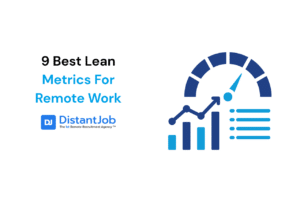Back in February 2013, Yahoo!’s new CEO and ex-Google wunderkind, Marissa Mayer banned working from home. In a memo to all staff, that was soon leaked, Yahoo! asked all staff with work-from-home arrangements to start working in offices.
This move made news around the world. It was heralded as the collapse of remote working. ‘Yeah but, if Yahoo! can’t make it work,’ the feeling went, ‘who can?’ But of course, it wasn’t the apocalypse for telecommuting that some feared (or hoped). Here we are, some five years later and remote working among the non-self-employed is the fastest growing employment sector.
But there’s no doubt that Mayer’s announcement did some damage to the acceptance of remote working. If you’ve tried to persuade a reluctant boss to let you work from home, they may have even used Yahoo! as the reason they don’t think it’s a great idea.
Here at DistantJob we passionately believe that remote working is the future, and we’re glad to be pioneers of specializing in remote recruitment. We also know that in every failure, there are lessons to be learned. So, we went back over what happened at Yahoo! and dissected it to see if we could discover what went wrong. Here’s what we found.
Why Did Yahoo! Recruit Marissa Mayer?
Marissa Mayer was a rising star at the time Yahoo! recruited her. She’d graduated from Stanford and been inundated with job offers. She’d decided to join Google, and was their 20th hire. Her influence at Google extended to the style of the home page, and the success of Google Adwords. She also recruited some of their brightest stars through her Associate Product Manager program.
Yahoo! poached her from Google, hoping to revive their flagging fortunes. They gave her a brief of cutting down on bureaucracy and improving the company culture. In other words, Mayer was given a specific brief to look at the working practices at Yahoo! and do what she could to improve them.
The Remote Working Ban
Which brings us to the ban on remote working. Mayer took over as CEO at Yahoo! in July 2012, so calling everyone into the office in February wasn’t a knee-jerk reaction. The memo, authored by Jackie Reses, says, ‘Some of the best decisions and insights come from hallway and cafeteria discussions, meeting new people, and impromptu team meetings.’ In other words, this is the old water cooler myth rearing it’s ugly head again.
It wasn’t just regular remote workers who got asked to stay in the office. The email also targeted those who stayed at home when needed, ‘for the rest of us who occasionally have to stay home for the cable guy, please use your best judgment in the spirit of collaboration.’ For whatever reason, Mayer had decided that she wanted her staff in the offices at all times.
Given that Mayer was hired to perform a corporate culture reset, it’s possible that there were some particular issues with the staff who were working remotely at Yahoo! Or perhaps there were lingering resentments from the office-based staff who felt they were missing out.
We’ve talked at length about those two underlying issues. Communication with your remote team, and between them and the on-site staff has to be a priority. There’s no reason why a remote team can’t operate jointly, and work collaboratively. It’s not about the staff; it’s about the management.
What Did The Staff Think?
It’s probably safe to say that Yahoo! staff were not impressed with the decision. The memo, which had been sent around labeled, ‘YAHOO! PROPRIETARY AND CONFIDENTIAL INFORMATION — DO NOT FORWARD’ was very quickly circulated by a ‘plethora’ of irked Yahoos.
And the staff weren’t alone. Richard Branson claimed to be perplexed by the decision. ‘Give people the freedom of where to work & they will excel,’ he tweeted.

We couldn’t agree more, Richard. Branson wasn’t alone, with industry leaders such as the CEO of FlexJobs and the editorial director of Working Mother Media also disagreeing. For many, it was seen as a step backward.
At the same time as Mayer was calling her folks back in, the CEO of Diebold, Andy Mattes was doing the exact opposite. Diebold had been struggling to recruit talent that lived near their offices in Canton, Ohio (even men they call Jayne). Instead, he offered remote working and attracted talent from Oracle, HP, and Intel.
A remote ban certainly flies in the face of what we know about what candidates are looking for. Global Workplace Analytics tells us that as many as 90% of the workforce would like to be able to work from home, at least part-time. And we know that remote workers are happier and healthier, and that translates into increased productivity for their employer.
Mayer Wasn’t Against Remote Working
In April of 2013, Mayer gave the closing Keynote at the Great Place to Work conference in Los Angeles. It was the first time she’d spoken about the remote working ban, and she had a few interesting things to say about, ‘the elephant in the room.’ The first was that her decision to call the Yahoos back to the office had been, ‘wrongly perceived as an industry narrative.’ In other words, Mayer had never meant to imply that remote working was wrong, just that it wasn’t right for Yahoo!, right then.
In the same speech, she also acknowledged that productivity is better when employees are working alone. What she wanted to encourage in Yahoo! was collaboration, and she felt that everyone being in the same place was better for that. That sentiment was one that drove Google to design their workspaces, so it’s not surprising that Mayer believes that to be true.
And that may have been truer in 2013 than it is now because there has been a whole raft of new tools to help remote teams to collaborate. In 2020, there’s no reason why staff from all around the globe can’t work together on projects, whether that’s in our specialist area of software development, or creative fields.
This Wasn’t The Only Change
Mayer made more than just this one policy change at Yahoo!, this is just the one that grabbed the biggest headlines. She also overhauled Yahoo!s working policies and oversaw the redesign of their Sunnyvale HQ. What changes did they make there? They moved their developers into new, purpose-built offices with standing desks and scrum boards. They redesigned their offices to help them work using the Agile Development Methodology.
But guess what! You can use Agile while your staff work from home, too. We’re big believers that the two work hand-in-hand together. So much so, that we’ve written a free eBook that explains the how’s and why’s.
It Didn’t Work
First and foremost, there’s a need to demolish the myth that no one from Yahoo! works from home. The truth is that they still do. Although Yahoo! declined to comment, a source told the Huffington Post that staff still work from home when needed and that some don’t have desks in the building at all.
And of course, for all of Mayer’s attempts to save it, she couldn’t turn Yahoo! around. A 2014 New York Times piece said more than a third of staff had left in that year. Meanwhile, a Glassdoor survey had a gloomy one-third of those questioned seeing improvements. In truth, she’d been given an impossible job.
It wasn’t just the staff who were complaining, one of Yahoo!’s shareholders sent a 99-page presentation to the board giving reasons for her removal in 2015. And then, of course, there was the data breach that saw 500 million user accounts stolen. Something Yahoo! hadn’t shared with their buyer, Verizon.
What was Yahoo! has now joined AOL as part of the Verizon owned company, Oath. They didn’t have a place for Mayer on their team (but don’t worry, her severance package was rumored to be about $60 million, she’ll be OK.)
And guess what Oath employees list as one of their benefits? You got it. Working from home.
There you have it. No sentence that starts, ‘Yeah but, Yahoo!’ should ever be listened to. The evidence is in, and remote working is still very definitely the future. If you have a vacancy, and you’d like us to search the globe for the very best remote developer to fill it, get in touch today.





